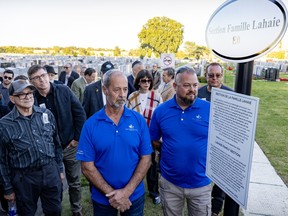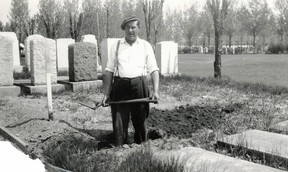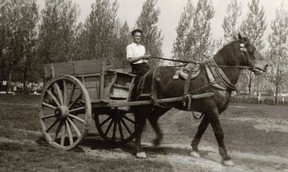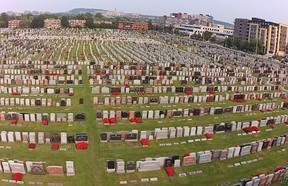Section of a Montreal Jewish cemetery named to honour the French-Canadian family that has maintained and cared for it for generations.

Article content
At Jewish burials, a mourner’s prayer is recited at the graveside, Rabbi Michael Whitman told a group gathered Monday evening at the Baron de Hirsch Cemetery on de la Savane St.
And he told of seeing Yves Lahaie, a foreman at the cemetery for 48 years, saying the prayer along with the mourners.
“It is an expression of acting with dignity and respect to the deceased,” he said.
Advertisement 2
Story continues below
Article content
They were gathered Monday, not for a funeral, but to honour members of the Lahaie family, who have been the cemetery’s caretakers and groundskeepers for four generations: A new section of the cemetery was named for the family and a plaque dedicated to them unveiled. Among those present were a few dozen members of the Lahaie family, along with members of the cemetery board.
Sixteen members of the Lahaie family have worked on the grounds and seven have been foremen. The first was Paul-Émile Lahaie in the 1930s. His sons Hormidas, Gaëtan, Émile, Henri and Jean-Louis followed and today his grandson Yves Lahaie and his great-grandson, Steve Lahaie, are the foremen — the people in charge of the grounds, of preparing graves for burials, pouring foundations and closing graves and for maintaining the 219,000-square-metre cemetery grounds and the gravesites at one of Montreal’s largest and oldest Jewish burial sites.

But there’s more to it.
“Their commitment to the cemetery goes beyond duty to be a legacy of service, respect and unwavering dedication,” said Jonathan Wise, executive director of the Baron de Hirsch—Back River Cemeteries. For many years, Baron de Hirsch Cemetery managed the Back River cemetery in Ahuntsic-Cartierville and the two cemeteries formally merged in 2013. More than 62,000 people are buried there, with graves going back to the 1890s.
Article content
Advertisement 3
Story continues below
Article content
In addition to managing the grounds with skill and care, Yves “built lasting relationships with many of our visitors,” Wise said. “His ability to remember where a visitor’s loved one is buried, even after many years, speaks volumes about his dedication and respect for the families who come to visit.”
His son Steve “has continued this legacy with the same commitment,” Wise said.

The men are “stewards of our heritage, guardians of our memories and trusted friends to many; their work is more than a job but a profound service to our community.”
At a time when “partnerships often seem fleeting, it is incredible to witness the enduring bond between the Jewish community and a single family working together for almost 100 years,” said cemetery president Alex Kestenbaum.
The Lahaie Family Section is “a symbol of the bond between the Lahaie family and Baron de Hirsch—Back River Cemeteries,” he said. “Your legacy is our legacy, and we are forever in your debt.”
Yves, 69, started at the cemetery in 1975 as a tractor operator. Preparing and closing the graves was a big part of his job. “It’s not easy. The family would be crying,” he said. “When people have pain, I feel their pain.”
Advertisement 4
Story continues below
Article content
To him, the work “is more a vocation than a job. Many people appreciate me. I have worked hard, but I am happy to be here for the people I have come to know and I have come to know many. It is really family for me,” he said. “Families are grieving when they come here and I try to help.”
Having a section of the cemetery named for his family “is like winning the 6/49,” said Steve, 43. “We are not Jewish and to put our name there is such a beautiful sign of respect to us and all that we do.”
Before Steve started at the cemetery in 2011, he worked in construction, operating machines, and learned a lot about the role of machinery. When he was approached to join the team at the cemetery, he agreed because he wanted a role in “changing methods from old to new … I always had a passion for the machines,” he said. He attends meetings and knows about new machinery used in places where space is tight. “Nights and weekends, I do research — and in winter, I solder and build equipment.”

The Lahaie Family section is at de la Savane and Mountain Sights Ave., where the cemetery caretaker’s residence had stood since the 1930s. The Lahaie family lived there for years — Yves was there nearly 50 years — but they moved out and the house was demolished a couple of years ago. There is space on the site for about 275 graves.
Advertisement 5
Story continues below
Article content
“This is a story of two communities, Jewish and French-Canadian, coming together over shared values — respect for those who have come before, caring and continuity,” Wise said. The Lahaie family is known and respected by rabbis, funeral directors and people at the monument companies, he said. There are 350 burials a year at the two locations, all but 30 to 35 at de la Savane.
“We are not just burying individuals. We are fixing and maintaining for perpetuity,” Wise said. “Thirty per cent of our work is burials and 70 per cent is maintenance.”
Technology has evolved so that today, cement foundations are poured 20 or 30 in a row, with special equipment used to strengthen the foundations with graphite fibres, Wise explained. And foundations of older graves that have shifted are poured “with the utmost care,” he said. More than 500 foundations have been repoured in the past two years, he said, and the drainage was redone in a section of the cemetery that was flooding.
“This is all Yves and Steve and their team,” Wise said. “That is where the family legacy and knowledge comes in.”
“Today, where employees jump from company to company to company. think of an organization where the same family has worked for close to 100 years,” he said. “The Lahaie family has their heart and soul in this business.”
Advertisement 6
Story continues below
Article content
Recommended from Editorial
Advertisement 7
Story continues below
Article content
Article content


Comments